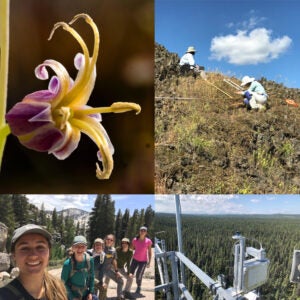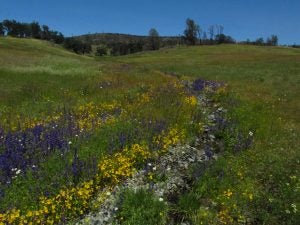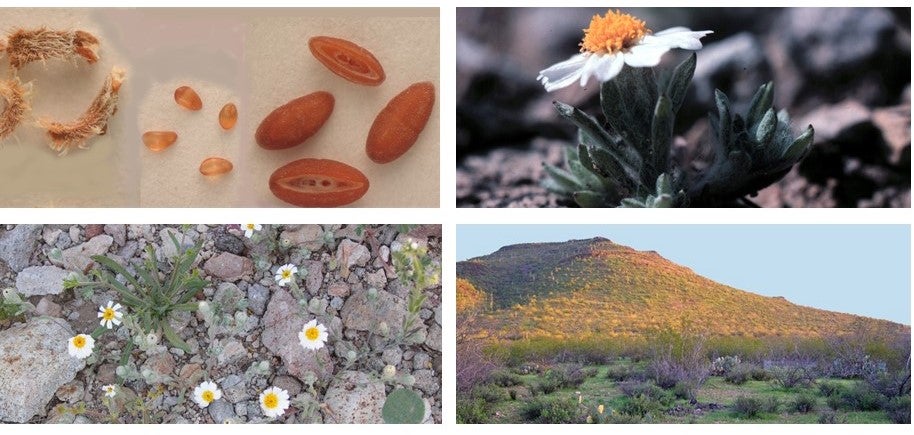Predicting population persistence or extinction in Streptanthus tortuosus
 Biodiversity is threatened by habitat loss and climate change, which has resulted in the acceleration of species extinctions across the world. The ability to predict how the genetic composition of populations impacts their long-term persistence or extinction in different and changing environments requires integrating analysis techniques and data across diverse fields. In this project, we are developing integrative demographic models that incorporate genetic, physiological, and life history traits to improve multi-generational predictions of population persistence and extinction for Streptanthus tortuosus (Mountain Jewelflower). The resulting integrative demography models will provide a road map for conservation biologists and managers to use genomic information to predict effects of different conservation strategies, such as assisted migration or introducing genetic variation, which can be applied across wild, managed, and agricultural species and populations. See our IntBio project website for more information.
Biodiversity is threatened by habitat loss and climate change, which has resulted in the acceleration of species extinctions across the world. The ability to predict how the genetic composition of populations impacts their long-term persistence or extinction in different and changing environments requires integrating analysis techniques and data across diverse fields. In this project, we are developing integrative demographic models that incorporate genetic, physiological, and life history traits to improve multi-generational predictions of population persistence and extinction for Streptanthus tortuosus (Mountain Jewelflower). The resulting integrative demography models will provide a road map for conservation biologists and managers to use genomic information to predict effects of different conservation strategies, such as assisted migration or introducing genetic variation, which can be applied across wild, managed, and agricultural species and populations. See our IntBio project website for more information.
Collaborators: Julin Maloof, Troy Magney, Denneal Jamison
Perennial grasslands responses to climate change
 Arid and semi-arid grasslands on the Colorado Plateau are already facing significant effects of climate change and these ecosystems provide critical services for diversity, forage, and other ecosystem services. Using a combination of long-term studies, as well as multi-year rainfall manipulation experiments at sites spanning an elevational gradient outside of Flagstaff, Arizona, we are studying how these grasslands will respond and the mechanisms driving those responses. To do so, we are investigating physiological, demographic, community, and ecosystem responses to temperature and precipitation. Our goal is to understand the mechanisms driving responses and how those scale from individual function to population and community dynamics to ecosystem function.
Arid and semi-arid grasslands on the Colorado Plateau are already facing significant effects of climate change and these ecosystems provide critical services for diversity, forage, and other ecosystem services. Using a combination of long-term studies, as well as multi-year rainfall manipulation experiments at sites spanning an elevational gradient outside of Flagstaff, Arizona, we are studying how these grasslands will respond and the mechanisms driving those responses. To do so, we are investigating physiological, demographic, community, and ecosystem responses to temperature and precipitation. Our goal is to understand the mechanisms driving responses and how those scale from individual function to population and community dynamics to ecosystem function.
Collaborators: Seth Munson, John Bradford, Brad Butterfield, Margaret Moore, Daniel Laughlin, Rachel Mitchell, Peter Adler
California annual grassland response to climate change
 California serpentine annual grasslands are diverse native plant communities that inhabit harsh, nutrient poor serpentine soils. These grasslands have already and will continue to experience significant effects of climate change. Current and recent projects have focused on understanding the role of seed banks in driving responses to global change factors, such as water and nutrients, and whether traits at the seed, vegetative (growth phase), and reproductive (flowering phase) stages can explain and predict responses to global change, both for the emergent community as well as in soil seed banks.
California serpentine annual grasslands are diverse native plant communities that inhabit harsh, nutrient poor serpentine soils. These grasslands have already and will continue to experience significant effects of climate change. Current and recent projects have focused on understanding the role of seed banks in driving responses to global change factors, such as water and nutrients, and whether traits at the seed, vegetative (growth phase), and reproductive (flowering phase) stages can explain and predict responses to global change, both for the emergent community as well as in soil seed banks.
Collaborators: Anu Eskelinen, Susan Harrison
Functional and demographic responses of Sonoran Desert winter annuals to variability
 The Sonoran Desert winter annual community has become a model system for linking functional biology to population and community processes. Dr. Larry Venable has monitored this annual community since 1982 leading to a long-term dataset on an entire plant community, providing a remarkable opportunity to link functional traits to population and community dynamics in a variable environment. In this system, we have combined this long-term data with trait measurements and experiments to understand how functional tradeoffs drive environmental responses and the consequences for population dynamics and species coexistence.
The Sonoran Desert winter annual community has become a model system for linking functional biology to population and community processes. Dr. Larry Venable has monitored this annual community since 1982 leading to a long-term dataset on an entire plant community, providing a remarkable opportunity to link functional traits to population and community dynamics in a variable environment. In this system, we have combined this long-term data with trait measurements and experiments to understand how functional tradeoffs drive environmental responses and the consequences for population dynamics and species coexistence.
Collaborators: Larry Venable, Travis Huxman, Amy Angert, Sarah Kimball
